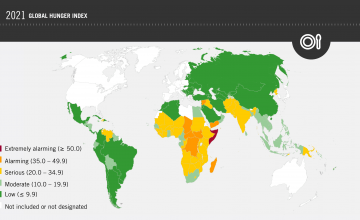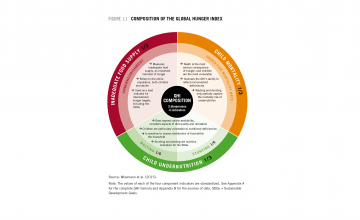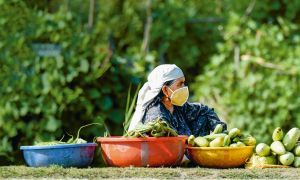
Read our 2023 annual report

Knowledge Hub
2021 Global Hunger Index
This is the sixteenth annual publication of the Global Hunger Index (GHI), a report jointly published by Concern Worldwide and Welthungerhilfe.

The 2021 Global Hunger Index (GHI) points to a dire hunger situation in a world coping with multiple crises. Progress toward Zero Hunger by 2030, already far too slow, is showing signs of stagnating or even being reversed.
Based on current GHI projections, the world as a whole—and 47 countries in particular—will fail to achieve a low level of hunger by 2030. Conflict, climate change, and the COVID-19 pandemic— three of the most powerful and toxic forces driving hunger—threaten to wipe out any progress that has been made against hunger in recent years. Violent conflict, which is deeply intertwined with hunger, shows no signs of abating. The consequences of climate change are becoming ever more apparent and costly, but the world has developed no fully effective mechanism to mitigate, much less reverse, it. And the COVID-19 pandemic, which has spiked in different parts of the world throughout 2020 and 2021, has shown just how vulnerable we are to global contagion and the associated health and economic consequences.
Although GHI scores show that global hunger has been on the decline since 2000, progress is slowing. While the GHI score for the world fell 4.7 points, from 25.1 to 20.4, between 2006 and 2012, it has fallen just 2.5 points since 2012. After decades of decline, the global prevalence of undernourishment—one of the four indicators used to calculate GHI scores—is increasing.
VIDEO: 2021 Global Hunger Index Report Launch
2021 GHI Map

Hunger and food systems in conflict settings
The focus of this year’s special essay by Caroline Delgado and Dan Smith of the Stockholm International Peace Research Institute (SIPRI) is on the intersection of conflict and hunger, and the steps we must take to break the links between the two in order to contribute to a more peaceful and food-secure planet.
The key messages from the essay are:
- The number of active violent conflicts is on the rise. Violent conflict remains the main driver of hunger, exacerbated by climate change and the COVID-19 pandemic.
- Food systems in conflict-affected countries are often characterized by a high level of informality, structural weakness, and vulnerability to shocks.
- Without achieving food security, it will be difficult to build sustainable peace, and without peace the likelihood of ending global hunger is minimal.
- The two-way links between conflict and increased food insecurity and between peace and sustainable food security are unique to each case and often complex.

The good news is that it is possible to begin to break the destructive links between conflict and hunger in the midst of ongoing conflict. Even where there is extreme vulnerability, it is possible to start building resilience.
- Breaking the links between conflict and hunger and harnessing the potential of food systems to contribute to peace will demand good contextual evidence, well-grounded knowledge of the setting, and cooperation between peace, humanitarian, and development actors.
- To integrate a peace-building lens into the creation of resilient food systems and a food security lens into peace building, we propose four priorities:
- A flexible and agile approach that reflects local perceptions, aspirations, and concerns;
- An emphasis on working in partnerships that bring together local, national, and international actors, with their diverse knowledge;
- Integrative work through hubs that convene key actors and build coalitions inclusive enough to advance peace and food security; and
- Commitment by major donors to get funds out of separate siloes and focus them on integrative work.
The value of the GHI as a composite index

The Global Hunger Index (GHI) is a tool designed to comprehensively measure and track hunger at global, regional, and national levels. GHI scores are calculated each year to assess progress and setbacks in combating hunger. The GHI is designed to raise awareness and understanding of the struggle against hunger, provide a way to compare levels of hunger between countries and regions, and call attention to those areas of the world where hunger levels are highest and where the need for additional efforts to eliminate hunger is greatest.
Measuring hunger is complicated. To use the GHI information most effectively, it helps to understand how the GHI scores are calculated and what they can and cannot tell us. You can find out more here.
Download the report in English and French:
The Global Hunger Index is also available in German, Spanish, Portuguese, Italian and Korean at this link:





